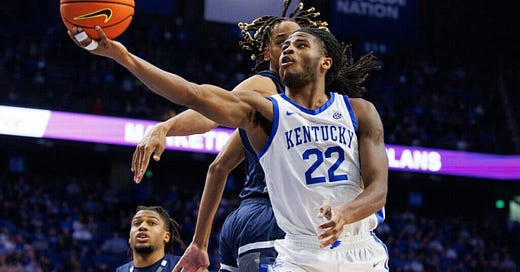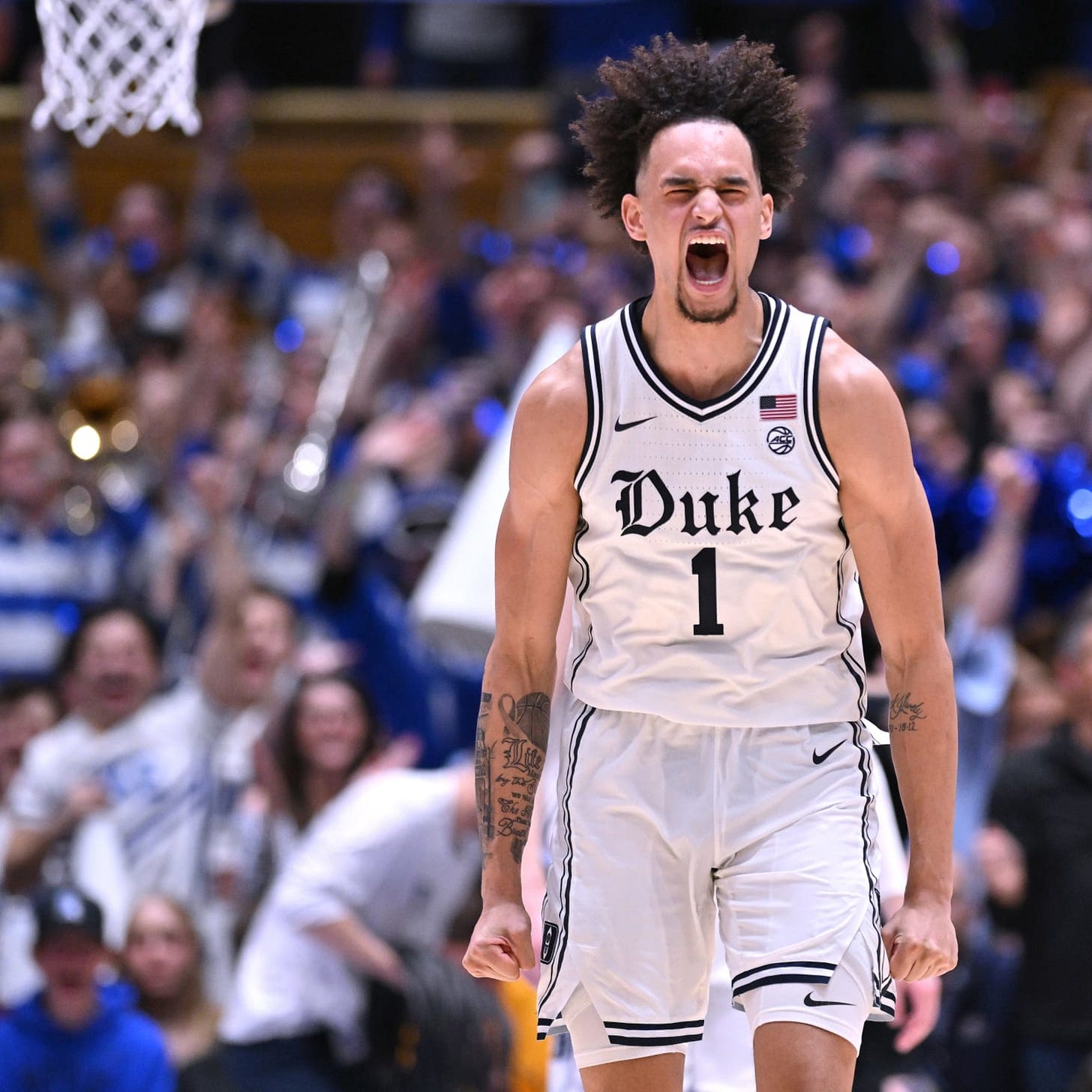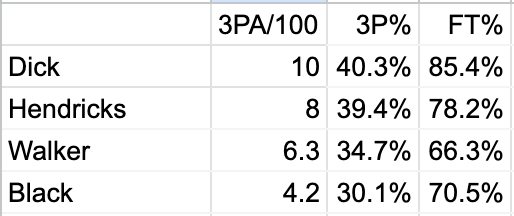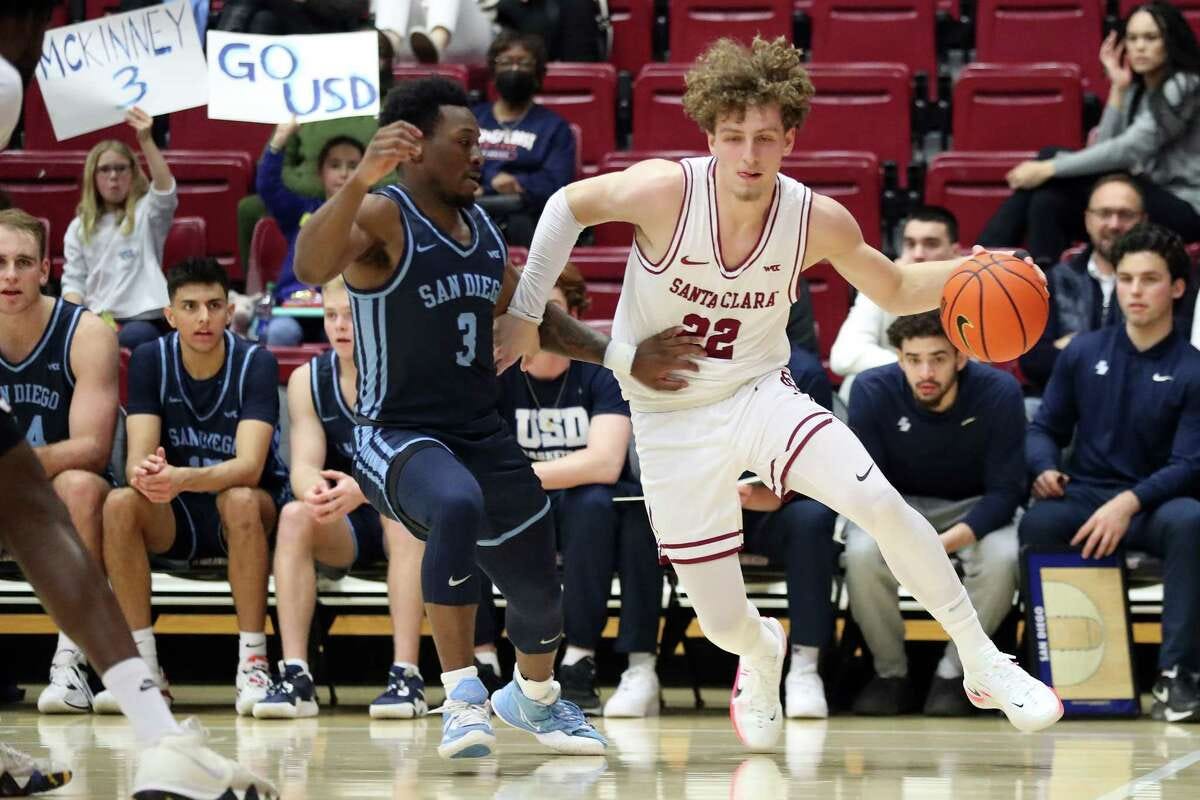Consensus has Wemby as a clear #1 with Scoot Henderson and Brandon Miller battling it out for #2, and then the draft gets wide open at #4 with a broad tier.
I rate Wemby and Miller as a clear #1 and #2, and then Scoot is in the next tier down with the following prospects. This is not an exact ranking, rather just an attempt to lay out the pertinent information on each prospect and discuss its implications.
Cason Wallace
Cason is a well rounded PG. He is 6’4 in shoes with 6’8.5 wingspan and is very strong and has solid athleticism. He is not a high volume shot creator, but he gets to the rim at an acceptable rate, had a strong 2:1 assist:turnover ratio, and is a solid shooter making 34.6% 3P 75.7% FT as a freshman.
He has excellent feel for the game as he always plays in control and is a highly cerebral defensive player. The worst thing that can be said about Cason is that he lacks top tier athleticism and scoring ability for a guard, but he is super solid across the board with no nagging weaknesses.
He has one very close statistical comp, and that comp is Jrue Holiday. Per 40 mins:
They are basically twins. Jrue was 7 months younger and better on the glass, but Cason scored a bit more with fewer turnovers. They are physically and stylistically similar, and no reason why Cason cannot achieve a similar level of NBA success.
Calipari guards often overachieve in the NBA, which could apply to Cason. He was forced to play offball next to 5’9 PG Sahvir Wheeler for the first half of the season, before an injury forced Cal to hand over the reigns to Cason.
Cason played in 17 games where Wheeler started or playing 22+ minutes off the bench, and 15 games that Wheeler missed or had trivial bench minutes. Here is how Cason’s numbers split between those games:
Average opponent D-Rtg is taken from a minute weighted average of kenpom D-Rtg for each matchup. Not only did Cason play against a schedule that was significantly tougher with Wheeler out, but he showed an ability to take on a significant uptick in his offensive role without missing a beat in terms of efficiency.
He had fewer spot up opportunities and worse shooting luck from 3, but he was clearly underused during the softer portion of Kentucky’s schedule.
This is largely why Eric Bledsoe and Immanuel Quickley massively outperformed their NCAA numbers in the NBA. Their PG skills were suppressed with limited touches playing off ball as secondary handlers.
Cason was only stifled for half of the season, but it is nice that he proved that he is capable of more for the half where he got to run the show. That said, it does not give him a leg up on Jrue who was forced to play second fiddle to senior Darren Collison for his entire freshman year.
This all circles back to Jrue being the upside comp. If you squint you can see some Cason possibly having some minor edges. Maybe he’s slightly more athletic, maybe he can create a bit more offense with fewer turnovers. But Jrue is the best defensive guard in the NBA, has shot 39.5% 3P in 3 seasons for Milwaukee, and has developed into a reasonably good creator.
These are all attainable benchmarks for Cason, but in all likelihood he falls short of at least one with no major advantage to offset it. Thus Jrue is the upside comp.
If Cason falls a bit short of Jrue he can still be a highly useful role player like Marcus Smart or DeAnthony Melton. It’s difficult to see him flopping completely without injuries, since he has excellent feel for the game and no major flaws.
Cason’s Underrated Archetype
Cason gets penalized for being a guard who is not likely to be a high volume scorer, when really he should be boosted for being a rare guard prospect who projects to be a positive defensively. Having a guard who can defend offers potential to build a defense with no weak links liable to be hunted in the playoffs. This archetype also pairs seamlessly with other stars, as Cason will not need the ball to be valuable.
Almost every small guard who is an offensive hub is a liability on defense, and if they are not a hyper efficient cheat code offensively like Steph Curry, it is extremely difficult to build a championship team around them. You need a perfect cast of defensive role players like the Bad Boy Pistons had around Isiah Thomas, because high volume guards lose significant value when they need to share the ball with other stars.
This is why I rate Cason Wallace above Scoot Henderson. With Cason you are hoping for Jrue Holiday, and with Scoot you are hoping for Derrick Rose. Jrue and Rose had similar peaks based on most advanced statistics, and the main difference is that Jrue has greater longevity and a ring since he pairs with a star like Giannis much better than Rose.
His lower friction mold makes his mid-tier outcomes much more useful as well, as he can still contribute to a contender as a role player whereas a mid-tier offensive hub sorely caps his teams upside.
Dereck Lively
Lively is a defensive big with an elite physical profile at 7’1 with good mobility. He said his wingspan was 7’7' to 7’8 in an interview, but measured 7’3 at the Hoop Summit last year, so it is difficult to know his exact length.
The sales pitch for him is an elite defensive big who protects the rim, moves his feet, and plays intelligent defense. He has clear DPOY upside as size, mobility, and IQ are the three most important traits on D.
Offensively, he is a lob finisher and a good passer, averaging 1.1 assists vs 0.7 turnovers per game— an excellent rate for a young big. He had some small chance of becoming a capable shooter, as he made 60% FT and occasionally attempted 3’s going 2/13.
His one glaring flaw is that he is not capable of creating offense whatsoever. If he catches the ball outside dunking range, he looks like he just caught a grenade and tends to quickly give the ball back. This presents some risk that he places a major strain on any offense he is a part of, and gives back much of his defensive goodness.
That said, it is not clear if this is that bad of a wart. Rudy Gobert was 1 year 8 months older the year he got drafted, and had 16% usage with a poor 11 assists vs 41 turnovers in France. This is a higher tier league than NCAA, but it would not be a significant leap for Lively to make from his 11.6% NCAA usage by the time he reaches Rudy’s age.
For reference, Emeka Okafor was several months older than Lively as a freshman, and had a similar usage with much worse efficiency. Then he leapt to 21.6% usage as a sophomore and 25% usage as a junior before getting drafted #2 overall and going on to a medium usage NBA career.
There are other examples of low usage bigs making major leaps offensively at a young age, albeit mostly not starting with quite as low usage as Lively. If he can make a leap in his ball skills as well as shooting skills, he has a tantalizing upside.
The only trouble is if he does not, he may be a major liability offensively and a fairly bland rotation player. And being a bland rotation player at big is worse than getting a bland rotation player at wing where OKish rotation players are more scarce.
Ultimately Lively’s rating comes down to two high leverage questions. 1) How likely is his lack of scoring going to result in him being a bland rotation player or bust and 2) How much is that risk worth stomaching for his upside to take him over the myriad of wing choices?
This makes him tricky to peg, but his intersection of height, mobility, and IQ almost never fails. And it’s not like he is Gobert or bust— there is some small chance he ends up better than Gobert with more passing + shooting, and if he is closer in value to a Steven Adams or Tyson Chandler that is still a good outcome mid-lottery.
He is somewhat of a higher risk, higher reward version of Walker Kessler who appears to be an elite steal from last draft, so it is tempting to try to replicate Kessler’s goodness with Lively this year.
Here are the wings who he is vying with for #5 on my board:
Anthony Black
Gradey Dick
Taylor Hendricks
Jarace Walker
These guys are all different flavors of 3 + D wings whose birthdays are within a few months of each other, so let’s run through a comparison of them in different categories. We will start with the most straightforward one in shooting:
It’s a fairly clear ranking if we sort by 3PA and 3P%. Dick is the clearly best shooter here, as he is wet from both 3P and FT. If there is a nitpick to be made, is that he could be getting off a larger volume of 3PA. Jordan Hawkins attempted 15.1 per 100, Jett Howard 13, Brice Sensabaugh 11.1. His NBA team will want him to improve his volume to maximize his value.
Taylor Hendricks is a clear #2. It is worth questioning exactly how much to trust his shooting since he was not reputed as a high level shooting prospect, but if nothing else he is comfortably ahead of Black and Walker.
Anthony Black is not that far behind Jarace Walker due to having a higher FT%. Granted, Walker only attempted 80 free throws which is a bit of a small sample so perhaps he is better than 66%. But on the flipside, he only had 101 3PA and could be worse than 34.7%.
Black’s main issue is lack of range, as he seems uncomfortable from 3 point range and often hesitates when open. This is something that can be improved over time, but will be a major issue if it is not.
Tools and Defense
Defense is fuzzy to assess, because it cannot be perfectly captured in the box score and requires eye testing to sharpen. But it is time consuming to eye test more than a small sample of the season, and even from watching it is not always clear how much every nuance matters. Let’s start with some raw data:
Dick offsets being the clearly best shooter by being the clearly worst defensive player. He is not hopeless on this end, as he is close to 6’8 in shoes and is fairly active and capable of making occasionally good places, as evidenced by his steal rate. But he is not the strongest or most athletic player and is fairly mistake prone on this end, as he can end up in bad positions from gambling. He is likely going to be below average in the NBA, although he has some chance of being neutral or slightly better.
As for the other three, it is not clear they should be ranked.
Anthony Black is the smallest, as he is more of a 2/3 while the others are closer to 4’s. He has the best instincts defensively, as he has extremely sharp reaction times to generate steals. He moves well and has the most impressive high end plays of the group, but also has some frustrating mistakes as he is prone to overgambling, getting beat off the dribble, and ball watching.
Walker and Hendricks both have enough shotblocking to play as small 5’s in a pinch, although not quite enough for that to be optimal for them. Walker has more steals, but that is largely because he is more comfortable gambling for them, and also is a bit jumpier for blocks.
Hendricks is a better bet to switch onto guards as he has excellent lateral mobility whereas Jarace is only OK. Hendricks can match up with a wide range of opponents and is difficult to beat, and does not get caught out of position as often as Walker or Black. He also fouls less than anybody in this group.
Hendricks seems a bit soft, as his rebound and foul rates are lukewarm for his size and athleticism and he vastly prefers to slip screens over absorbing the contact. But Walker has a surprisingly low free throw rate himself for such a thick guy. Black is the only one of the group who gets to the line frequently.
I expected to like Walker defensively more than Hendricks from the numbers, but from watching my perspective was flipped. Anthony Black is super cerebral guy who needs to clean up some mistakes on defense, and it’s tough to say who projects better between him and Hendricks.
Ultimately, I’d say flip a coin between Black and Hendricks for #1, put Walker not too far behind at #3, and Dick a distant #4.
Creation
Note that “rim creation” is rim baskets self created in half court per 40 based on play by play data.
Anthony Black has by far the most potential here because he got to the rim the most, the line the most, and created by far the most offense for his teammates. He has some turnover issues that can use cleaning up, but he has potential to develop into at least a #2 creator.
Walker and Hendricks are close as scorers, but Walker has a clear advantage as a passer. It would be nice if he could develop as a scorer to open up opportunities to make use of his passing, but it seems like a bit of a longshot. He is not a great shooter, and he did not get to the rim or the line much. This is not a death knell, as Donovan Mitchell was not a big creator in college and then instantly became a 29 usage player as an NBA rookie. But Mitchell is a super athlete which Walker is not, so it is difficult to see Walker’s path.
Hendricks has bit more athletic pop than Walker, and has some chance of developing into a scorer like Jerami Grant, although he may be better off if not without a strong passing game to complement it.
Gradey Dick does not have the athleticism to have any real creation potential, but he does move well off the ball and is a solid passer.
Overall
Anthony Black stands out as having the highest upside of the group. He needs to improve his shooting range, and he is a bit sloppy on both ends as he is prone to turnovers on offense and mistakes on defense. But his instincts are exceptional, and he has enough vision, handling, and athleticism to develop into a two way star. He essentially has the upside that mainstream consensus believes the Thompson twins possess.
Granted, he needs quite a bit to go right for this to happen, and his more common outcomes may be more similar to an Evan Turner type. His median outcome may be better than Evan Turner, but not by much. With mediocre development he is going to be a high friction player who is not that useful. But if everything falls into place, he has as much upside as anybody outside of the top 3.
Taylor Hendricks is a low friction guy who has the best 3 + D profile of the group but somewhat bland upside. There is a reasonable case that he has the best defensive potential of the group, and he offers clearly better shooting than Walker or Black.
Jarace Walker is an odd prospect. He has a great intersection of dimensions and intelligence, which is typically an indicator of sneaky upside. But he is not quite as intelligent on defense as he is on offense, and offensively he lacks the skills to maximize his passing ability. So it’s tough to know what this amounts to. Perhaps he can be an Aaron Gordon type, but he seems closer to Bobby Portis.
Gradey Dick’s sales pitch is (hopefully) elite shooting with SF size and OK enough everything else. You are pretty much hoping for Kyle Korver, who was an underappreciated role player in his time but is highly valuable in the modern NBA. How high can you target Kyle Korver upside knowing that you are more likely going to end up with a Kevin Huerter type?
When in doubt, it is fair to give the edge among this group to Anthony Black for his upside. But the other 3 guys are difficult to grapple with. It is easy to go back and forth on them between being happy to take a solid role playing wing vs. being offput by their blandness.
Brandin Podziemski
The statistical darling of the class, Podz offers an incredibly unique profile. He has mediocre SG dimensions at 6’3.75” without shoes and 6’5.5” wingspan, and is not particularly athletic with subpar lateral mobility, so he is currently projected to go outside the lottery.
But he is strong, skilled, and has excellent feel for the game. He plays a highly efficient style offensively, as he rarely overdribbles and quickly makes decisions. This results in a low turnover rate, as he averaged 19.9 pts 3.7 assists and only 2.3 turnovers per game.
He offers a bit of everything as a scorer, as he has a bit of shake to get to the rim, nice touch on his floaters, strength to post up smaller guards, and a good shooting ability making 43.8% 3P on 5.8 3PA/game and 77% FT.
His passing looks better than expected relative to his assist rate. He makes good reads, quick decisions, and his passes are accurate and a bit saucy.
Defensively he is slow and prone to getting beat off the dribble even by mid-major guards, and sometimes gets caught out of position from gambling. But he is extremely active with an excellent motor, and averaged a ridiculous 8.8 rebounds per game in spite of being a less athletic guard. He has sharp instincts and makes intelligent rotations, and there is some chance that he can overcome his lack of speed on this end with effort and intelligence.
He has such a unique distribution of strengths, it is difficult to pick any clear comps. The concern would be that the athleticism limits both his creation and defense, and he is a role player like Luke Kennard or Grayson Allen who contributes spot up shooting and not much else.
But there are a number of ways for things to go right for him. He could become a scrappy defensive player, he could find a way to create offense on sheer craft, he could expand his passing, or he could give you a bit of everything.
Austin Reaves or Josh Hart would be a comp in the “bit of everything” role player outcome. If he becomes a wet shooter with secondary creation, he could be something like a Desmond Bane type. Statistically he has a fairly similar profile to CJ McCollum, who also had a high rebound rate playing against non-high major competition, except Podz is 1.5” taller.
If you want to be super optimistic, there are parallels to Tyrese Haliburton, except Hali was a pure PG at the same age instead of a SG with good passing like Podz. So it may be as much to ask him to be THAT good. But Hali just turned 23 and is already super good. He appears on track to become 1st team all-NBA and possibly even an MVP candidate once he hits his prime, so it’s not exactly a bad thing if Podz upside is “only” a tier worse than Hali.
It’s difficult to project Podz’s NBA future with any confidence because he is such a unique player. But it wouldn’t be a surprise to see him rise on draft night given the success of Jalen Williams as a later riser from Santa Clara last year.
The safe heuristic would be to take him after all of the quality one and done wings who fit more traditional molds are off the board. But the safe play is not always the best play.
What happens if Gradey Dick slides to the late lottery and a team is choosing between Dick and Podz? Dick is slightly younger and a 5* talent with a more obvious NBA fit. But Podz has more dimensions to his game which gives him more upside, and was a top 100 recruit himself. It’s not an easy decision.













Hello Dean
How do you think Kobe Bufkin fits in within the Cason Wallace/Scoot Henderson top lead guard convo he lacks the PG skills of both and doesn't have the Jrue defensive potential of Wallace due weaker frame but has solid offensive package and is young for his class if he shown more range on his jumper or looked more dominant slashing he would be getting top 5 hype in my opinion
I'm looking into Hendriks and Walker and don't hate them, but I think their value is very inflated since this draft is so short on big men. I think they would often be taken in the mid to late teens, but since they are the best of the bunch they are considered top 8. No one seems to bring up their competition and everyone brings up Podz's despite their competition being the same level, possibly a little worse.
Podz was also a one man team and they both played on good (Hendriks) to stacked (Walker) teams:
https://www.sports-reference.com/cbb/schools/houston/men/2023.html
https://www.sports-reference.com/cbb/schools/central-florida/men/2023.html